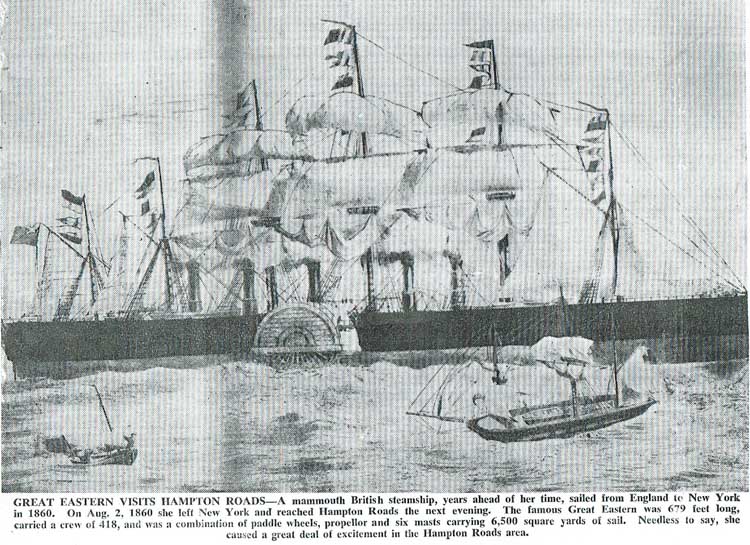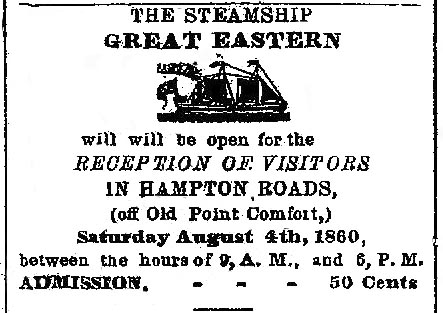Historical
Reminiscing with Robert B. Hitchings
Copyright.
All rights reserved.
The Great Eastern Steamship Came to Hampton Roads, August 3, 1860
Nor forget I to sing of the wonder, the ship as she swam up my bay,
Well-shaped and stately the Great Eastern swam up my bay, she was 600 ft long,
Her moving swiftly surrounded by myriads of small craft I forgot not to sing.
Walt Whitman, the Year of the Meteors (1859-1860)

Somehow, the men in my family and I have always been fascinated with large passenger liner ships. As I have told my two sons, “Apparently it is all in the blood, in our DNA.” The great Atlantic liners that once crossed the Atlantic Ocean for centuries were synonymous with ocean passage. Not many individuals could afford to travel and only the rich could afford the luxury to cross the Atlantic.
I can remember my father and his brother taking me to see the luxury liner United States when she was at the Norfolk International Terminals. To walk the decks of this liner was a thrill, knowing how many famous people in the 1950’s had walked the same decks that I was walking on when they crossed the Atlantic ocean so many years ago.
Several years ago, I came across a fantastic article in the Ledger Dispatch newspaper, dated October 13, 1911, concerning a huge luxury ship, called the Great Eastern. The title of his article was "When the British Steamship Great Eastern Was in Hampton Roads," by Henry Boswell Bagnall (1847-1913).
Like many, I had not heard of this great ship, but to find out that one of my ancestors was there to meet and greet this huge ship here in Hampton Roads was quite astonishing. Here is the story of the Great Eastern.
Henry B. Bagnall was an old Norfolkian who recalled that day in August 1860 seeing this colossal ship. As a 13-year old youth, he was one of the many spectators who witnessed seeing the Great Eastern coming up the Chesapeake Bay. I am sure, like so many, this event was awesome!
In his original article in the Ledger Dispatch, he describes my ancestor Captain David D. Hitchings (1822-1862) who was the first to witness the Great Eastern coming up the Chesapeake Bay. Immediately Capt. Hitchings sailed back and reported the news to the editors of the Norfolk’s Day Book newspaper. The Great Eastern ship had arrived. Capt. Hitchings sailed out on a pleasure yacht with family and friends and was the first to bring back the news to Norfolk that the Great Eastern was in our waters. The date was August 3, 1860. I am sure young Henry Bagnall and many others were just shocked and astonished at the size of this monmouth ship coming into our waters. Here is how the Norfolk Day Book newspaper described the Great Eastern coming to Hampton Roads.
On August 4, 1860, at 6 o’ clock the Great Eastern came to anchor between Fort Calhoun (today Fort Wool) and Fortress Monroe in about 50 feet of water. When she passed, about ten thousand people lined the beach all the way from Fog Bell to the front of the Hygeia Hotel. Old and young, male and female, white and black, all colors, sizes and conditions thronged the shore, and as the ponderous “mud hook” of the British wonder touched the waters of Virginia, a shout, long and loud went up from the multitude which echoed back the guns of the British.
A salute was then fired from the beach in acknowledgement of the flag of St. George had dipped. At this time forty odd sails of vessels and ten steamers were seen resting upon the bosom of Hampton Roads. The Great Eastern swung lazily around to the tide while the various craft played around her like many minnows around a huge whale. The largest and smallest steamer ever seen in Hampton Roads then rode side by side – the Great Eastern of London, and the “Atlantic” of Norfolk.
It would be almost impossible to describe her appearance as she came into the harbor. Or the great excitement among the spectators. Had one of the Peaks of Otter been moved from its solid foundation and seen floating into the Roads, it would not have looked larger that did this summer vessel. Her wheels revolved with great rapidity and threw the white spray a full fifty feet, while her huge propeller ploughed up the water behind and raised vast quantities of it full thirty feet in the air. This was the Great Eastern.Isambard Kingdom Brunel (1806-1859) a successful engineer, building bridges in England and then turning to ship building. His dream was to build a colossal ship that would be the envy of the world. However, his dream of a mammoth ship caused lots of big problems. He had problems at the launch, money problems and accidental deaths. In the end Mr. Isambard Brunel would have several strokes that finally took his life in 1859 all due to this huge ship.
In 1852 the Eastern Steamship Company was formed for the purpose of transporting freight and passengers. These directors accepted the design of a new colossal ship and the engineer who designed her was Isambard Brunel. The Great Eastern was born. “The Wonder Ship,” was built in the Millwall shipyard on the Thames. The plans called for a steamship so large and included additional space of 5,000 tons of cargo, 4,000 passengers or more, and a super space for 15,000 tons of coal. Everything on this ship was huge including the chains that dragged her in the Thames River.
The Great Eastern was launched in 1858. She was the largest iron and wooden ship and with a length of 692 and a beam of 120 feet, she dwarfed all but the ocean liners of today. Knowing her super size today, she could not pass through the Panama Canal or the Suez Canal.
The Great Eastern left Southampton, England, for New York at the appointed time, June 17, 1860. On her maiden voyage she only had 38 passengers and 8 guests from New York were on board. Her voyage only took 11 days in crossing the Atlantic. As the owners needed money, a price of $1 was charged to let people see one of the “Eight Wonders of the world.”
On board that day were two distinguish passengers who were looking for investments in our area: Marshall Parks, Jr. of Norfolk, Virginia, and William Richie, editor and part owner of the Richmond Enquirer. As the steamship approached the Capes, these distinguish passengers assembled in one of the beautiful saloons. They raised their glass to Captain John Vines Hall for a successful crossing.
As one of the local newspapers of the day reported, the hotels of our area were doing a super job with visitors. When the Great Eastern arrived in Hampton Roads about 6 PM on that hot day in August 8, 1860, the ship’s band played many of latest hits, especially "Hail Columbia". Cannons boomed in the distance along with rifle fire. There was excitement in Hampton Roads.
Spectators lined the shore to get a glance of her. An estimated 50,000 curious people crowded and flocked to our area just to see this mammoth ship. Many said she looked like Noah’s Ark.
After two days in Hampton Roads, this monster ship with its huge 58 foot paddle wheels left Hampton Roads, not without stirring up all the dirt, silt and sand from the bottom of the harbor. She sailed up the Chesapeake to Annapolis, Maryland, with lots of fanfare.
The Great Eastern was advanced for her time, a marvel of technology that she was so huge she had a difficult time in being launched on the Thames River. She was the monster of the seas. This ship was designed to carry 4,000 passengers, twice as many as her great-grandchild, the Lusitania in 1906.
Unfortunately, she seemed to be jinxed at the very beginning. As she was being built, she killed, maimed and financially ruined hundreds of people. The Great Eastern's career was a combination of high drama, high comedy and high grim tragedies. And with all these accounts, the newspapers of the day could not get enough news of the Great Eastern.
This is the ship that killed her designer, drowned her first captain, had several mutinies, killed thirty-five men, survived the worst and weirdest Atlantic storms, laid the first Atlantic Cable and accidently sank four ships. However, with all of this, she created six men who received knighthoods. And she was on the auction block several times. This monster ship of the seas caused heavy financial losses to so many including Emperor Louis Napoleon of France.
Over two million sightseers visited her before she ended her career as a floating circus.
No one is around today that remembers the Great Eastern. She is remembered in old yellow-brown newspapers clippings, but it was Henry Boswell, educator, and writer, who set pen and paper down to write an eye-witness account of this large mammoth ship coming to Hampton Roads on that hot day in August 3, 1860.
* * * * * * * * * *
Robert B. Hitchings is a seventh generation Norfolk resident, graduating with an Associate's Degree in Biology from Old Dominion University and BA in history from Virginia Wesleyan University. During his studies he was awarded a scholarship at Emmanuel College, Cambridge, England, and he was an exchange student at Brooks-Westminster College, Oxford, England. From 1999-2014 he worked as head of the Sargeant Memorial History Room at Norfolk Public Library, and since then has headed the Wallace History Room at Chesapeake Public Library. He is also the President of the Norfolk County Historical Society, and for six years was a columnist for The Virginian-Pilot. Robert may be reached at nchs.wallaceroom@gmail.com
